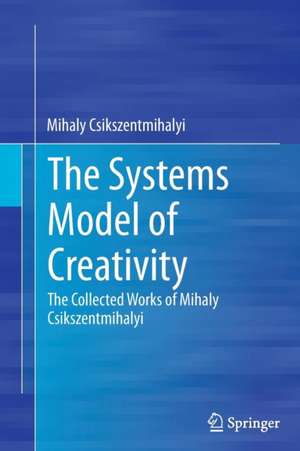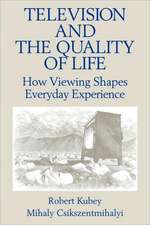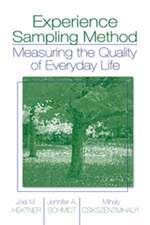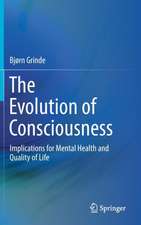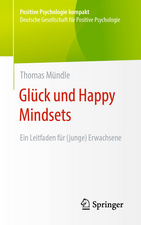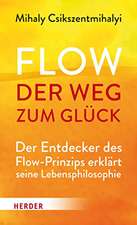The Systems Model of Creativity: The Collected Works of Mihaly Csikszentmihalyi
Autor Mihaly Csikszentmihalyien Limba Engleză Paperback – 9 oct 2016
The chapters in this volume trace the history of the study of creativity back to the days of Guilford and research on IQ and Jacob Getzels’ work on creativity and intelligence. Firmly grounded in that history, yet extending it in new directions, Mihaly Csikszentmihalyi started his life-long study on artistic creativity. His first extensive study at the School of the Art Institute of Chicago enabled him to observe, test and interview fine art students drawing in a studio. The study formed the very basis of all his work on the subject and has resulted in several articles, represented in this volume, on such creativity-related concepts as problem solving versus problem finding, the personality of the artist, the influence of the social context, creativity as a social construction, developmental issues and flow. The main contribution to the topic of creativity and also the main concept explored in this volume, is the Systems Model of Creativity. Seven chapters in this volume discuss the development of this conceptual model and theory.
| Toate formatele și edițiile | Preț | Express |
|---|---|---|
| Paperback (1) | 431.89 lei 38-44 zile | |
| SPRINGER NETHERLANDS – 9 oct 2016 | 431.89 lei 38-44 zile | |
| Hardback (1) | 442.87 lei 38-44 zile | |
| SPRINGER NETHERLANDS – 6 feb 2015 | 442.87 lei 38-44 zile |
Preț: 431.89 lei
Preț vechi: 539.86 lei
-20% Nou
Puncte Express: 648
Preț estimativ în valută:
82.65€ • 85.97$ • 68.23£
82.65€ • 85.97$ • 68.23£
Carte tipărită la comandă
Livrare economică 10-16 aprilie
Preluare comenzi: 021 569.72.76
Specificații
ISBN-13: 9789401778589
ISBN-10: 9401778582
Pagini: 341
Ilustrații: XXIV, 317 p. 18 illus.
Dimensiuni: 155 x 235 x 18 mm
Greutate: 0.48 kg
Ediția:Softcover reprint of the original 1st ed. 2014
Editura: SPRINGER NETHERLANDS
Colecția Springer
Locul publicării:Dordrecht, Netherlands
ISBN-10: 9401778582
Pagini: 341
Ilustrații: XXIV, 317 p. 18 illus.
Dimensiuni: 155 x 235 x 18 mm
Greutate: 0.48 kg
Ediția:Softcover reprint of the original 1st ed. 2014
Editura: SPRINGER NETHERLANDS
Colecția Springer
Locul publicării:Dordrecht, Netherlands
Cuprins
Introduction.- 1. Discovery-oriented Behavior and the Originality of Artistic Products: A Study with Artists; M. Csikszentmihalyi and J.W. Getzels.- 2. The Personality of Young Artists: A Theoretical and Empirical Exploration; M. Csikszentmihalyi and J.W. Getzels.- 3. Culture, Time and the Development of Talent ; M. Csikszentmihalyi and R. Robinson.- 4. Society, Culture and Person: A Systems View of Creativity; M. Csikszentmihalyi.- 5. Solving a Problem is not Finding a New One: A Response to Herbert Simon: M. Csikszentmihalyi.- 6. Shifting the Focus from Individual to Organizational Creativity; M. Csikszentmihalyi and K. Sawyer.- 7. Creative Insight: The Social Dimension of a Solitary Moment: M. Csikszentmihalyi and K. Sawyer.- 8. Creativity and Genius: A Systems Perspective; M. Csikszentmihalyi and K. Sawyer.- 9. The Social Construction of Creative Lives; C. Mockros and M. Csikszentmihalyi.- 10. New Conceptions and Research Approaches to Creativity: Implications of a Systems Perspective for Creativity in Education; M. Csikszentmihalyi and R. Wolfe.- 11. The Pauling; J. Nakamura and M. Csikszentmihalyi.- 12. The Motivational Sources of Creativity as Viewed from the Paradigm of Positive Psychology; J. Nakamura and M. Csikszentmihalyi.- 13. The Group as Mentor: Social Capital and the Systems Model of Creativity; C. Hooker, J. Nakamura and M. Csikszentmihalyi.- 14. The Artistic Personality: A Systems Perspective; S. Abuhamdeh and M. Csikszentmihalyi.- 15. Creativity through the Life Span from an Evolutionary Systems Perspective; M. Csikszentmihalyi and J. Nakamura.- 16. Cortical Regions Involved in the Generation of Musical Structures During Improvisation in Pianists; S.L. Bengtsson, M. Csikszentmihalyi and F. Ullen.- 17. Creativity and Responsibility; M. Csikszentmihalyi and J. Nakamura.- 18. Complexity and Creativity; G. Gute, J. Nakamura and M. Csikszentmihalyi.
Notă biografică
A Hungarian psychology professor, who emigrated to the United States at the age of 22. Now at Claremont Graduate University, he is the former head of the department of psychology at the University of Chicago and of the department of sociology and anthropology at Lake Forest College. He is noted for both his work in the study of happiness and creativity and also for his notoriously difficult name, in terms of pronunciation for non-native speakers of the Hungarian language, but is best known as the architect of the notion of flow and for his years of research and writing on the topic. He is the author of many books and over 120 articles or book chapters. Martin Seligman, former president of the American Psychological Association, described Csikszentmihalyi as the world's leading researcher on positive psychology. Csikszentmihalyi once said "Repression is not the way to virtue. When people restrain themselves out of fear, their lives are by necessity diminished. Only through freely chosen discipline can life be enjoyed and still kept within the bounds of reason." His works are influential and are widely cited.
Textul de pe ultima copertă
This first volume of the Collected Works of Mihaly Csikszentmihalyi represents his work on Art and Creativity. Starting with his seminal 1964 study on creativity up to his 2010 publication in Newsweek, the volume spans over four decades of research and writing, and clearly shows Csikszentmihalyi’s own development as an academic, psychologist, researcher and person. Unconventional and unorthodox in his approach, Csikszentmihalyi chose the topic of creativity as a field of study believing it would help him be a better psychologist and advance his understanding of how to live a better life.
The chapters in this volume trace the history of the study of creativity back to the days of Guilford and research on IQ and Jacob Getzels’ work on creativity and intelligence. Firmly grounded in that history, yet extending it in new directions, Mihaly Csikszentmihalyi started his life-long study on artistic creativity. His first extensive study at the School of the Art Institute of Chicago enabled him to observe, test and interview fine art students drawing in a studio. The study formed the very basis of all his work on the subject, and has resulted in several articles, represented in this volume, on such creativity-related concepts as problem solving versus problem finding, the personality of the artist, the influence of the social context, creativity as a social construction, developmental issues, and flow. The main contribution to the topic of creativity, and also the main concept explored in this volume, is the Systems Model of Creativity. Seven chapters in this volume discuss the development of this conceptual model and theory.
The chapters in this volume trace the history of the study of creativity back to the days of Guilford and research on IQ and Jacob Getzels’ work on creativity and intelligence. Firmly grounded in that history, yet extending it in new directions, Mihaly Csikszentmihalyi started his life-long study on artistic creativity. His first extensive study at the School of the Art Institute of Chicago enabled him to observe, test and interview fine art students drawing in a studio. The study formed the very basis of all his work on the subject, and has resulted in several articles, represented in this volume, on such creativity-related concepts as problem solving versus problem finding, the personality of the artist, the influence of the social context, creativity as a social construction, developmental issues, and flow. The main contribution to the topic of creativity, and also the main concept explored in this volume, is the Systems Model of Creativity. Seven chapters in this volume discuss the development of this conceptual model and theory.
Caracteristici
Provides an impressive overview of 40 years of research on art and creativity Reflects a very personal journey and illustrates the evolution of a scientist Clearly demarcates one specific area in Mihaly Csikszentmihalyi’s broad field of interest Includes supplementary material: sn.pub/extras
